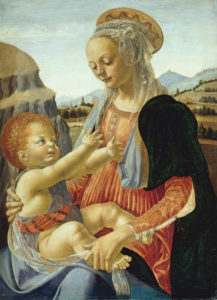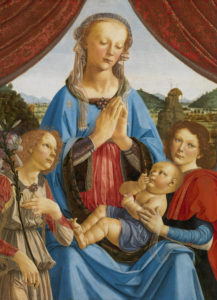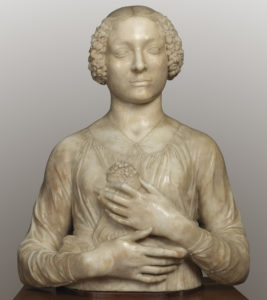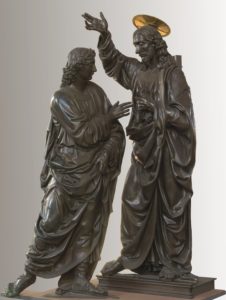Until July 14, the rooms of Palazzo Strozzi in Florence host Andrea del Verrocchio: Master of Leonardo, the first monographic exhibition ever dedicated to the artist. It is a one of a kind show, displaying over 120 works lent by the most important museums worldwide in two exceptional locations: Palazzo Strozzi (rooms 1 to 8) and the Museo del Bargello (rooms 9 and 10). The project’s advanced level of research and the involvement of primary art institutions pay homage to the exhibition’s protagonist. Active in the third quarter of the fifteenth century as a sculptor, a painter and a goldsmith, Andrea del Verrocchio run one of the most successful workshops in Florence, vaunting pivotal artists among his pupils: Domenico del Ghirlandaio, Bartolomeo della Gatta, Lorenzo di Credi, Pietro Perugino, perhaps Sandro Botticelli, and, obviously, Leonardo. One of the two exhibition curators, Professor Francesco Caglioti, gives us a closer look into such an ambitious project.

The exhibition Andrea del Verrocchio: The Master of Leonardo reveals the pivotal role Verrocchio played in shaping the arts of Florence during the time of Lorenzo the Magnificent and the following decades. It has taken a long time for Italian scholarship to acknowledge the importance of Verrocchio’s impact on Florentine art. An updated monographic publication on the artist was published in 2005 by Dario A. Covi (Andrea del Verrocchio: Life and Work), and this year’s show at Palazzo Strozzi is the first monographic exhibition ever dedicated to Verrocchio. Why has it taken so long for such a project to finally come alive?
The reasons are many and intricated. I will therefore try to pinpoint the most essential ones. The first reason is that it is not easy to present a monumental master of the past in the closed space of a museum. Several of Verrocchio’s major masterpieces remain today in their original locations, often outdoors, and cannot be moved. One can think of the two Medici tombs in the Church of San Lorenzo in Florence, the Equestrian statue of Bartolomeo Colleoni in Venice, and even the small silver Beheading of Saint John the Baptist, today at the Florence Museo dell’Opera del Duomo, whose loan we avoided asking in order to respect its original context, i.e. the old altar cover for the Florentine Baptistery. In the exhibition catalogue, we underline how Verrocchio’s artistic genesis is indebted in the work of both Donatello and Desiderio da Settignano. It was possible for us to show the relationship between Verrocchio and Desiderio because of the small dimensions of some works by the latter and early works by the former. On the contrary, we could not show Verrocchio’s relationship with Donatello due to lack of space and the excessive dimensions of the woks we would have needed. Secondly, a detailed exhibition on Verrocchio could only have been organized in Italy, where the Museo del Bargello hosts the biggest corpus of autograph works by the master indoor. Yet, Italian scholars of the last century paid little attention to Verrocchio, leaving the study of this master to scholars from other countries. In the past thirty or forty years, Italian scholarship has renewed interest in Verrocchio’s work and the Florentine early Renaissance, thus opening up the possibility to eventually make such a project come true. Thirdly, Verrocchio has so far enjoyed a curious critical fortune, mostly shaped by Giorgio Vasari’s diminishing judgement. In his Vite, in the foreword to the life of Verrocchio, Vasari documented Verrocchio’s function as the master of Leonardo and other artists, yet he did not pinpoint his pivotal role in shaping an entire artistic era, that of Lorenzo the Magnificent. Consequently, there has never been a scholar interested in presenting Verrocchio as an absolute protagonist of his time, as, instead, me and Andrea de Marchi have done in this show.
What was the most significant legacy that Verrocchio left to Florentine art and, was there a legacy outside of Florence?
Verrocchio’s legacy was incalculable. Verrocchio has probably been the father of the Modern Manner, allowing it to happen by directly training his pupils, such as Leonardo, and indirectly influencing artists, such as Ghirlandaio and Perugino, who later became the masters of Michelangelo and Raphael respectively. Verrocchio’s legacy outside of Florence was also enormous, spreading especially throughout central Italy, even reaching remote areas of Abruzzo. In order to document it, we would have needed more works on display, more space, and a longer catalogue, thus risking to lose or bore that part of the public usually interested in a blockbuster exhibition such as ours.

The Virgin and Child with Two Angels, c. 1471–2, tempera on panel, 96.5 x 70.5 cm. London, National
© The National Gallery, London
The exhibition seems to focus its attention primarily on the reception of Verrocchio’s innovations in the works executed by his pupils. Something the show seems to explore less is the reciprocal influence between sculpture and painting within Verrocchio’s own work.
I do not quite agree. Simply, Verrocchio’s autograph paintings are very few and, therefore, their display cannot occupy much space within an exhibition of about 120 works. In the third room of Palazzo Strozzi, all of Verrocchio’s Madonne are exhibited in direct dialogue with the terracotta and marble Madonne executed by him and his close assistants, such as Francesco Ferrucci. A similar display has never been seen before. I am almost certain that it could only be surpassed if, one day, another painting by the hand of Verrocchio will be miraculously found – for example, the lost portrait of Lucrezia Donati – the lover of Lorenzo the Magnificent, recalled by ancient sources – whose comparison with Leonardo’s Ginevra de’ Benci would certainly benefit scholarship. A crucial early painting by Verrocchio is the Argiano Crucifixion, which, however, was stolen almost a half century ago and was never recovered. The Baptism of Christ, today at the Uffizi, would also have been extremely useful for a comparison between Verrocchio as a painter and a sculptor. Unfortunately, we could not include the painting in the exhibition.

Considering the exhibition’s focus on the relationship between Verrocchio and Leonardo, which were the reasons why works such as those you just mentioned, the Portrait of Ginevra de’ Benci and The Baptism of Christ, have not been included in the show, and in which way their display could have been beneficial to the exhibition?
The reasons are very simple. These loans were denied by the museums that own them, which have, however, lent us other of their masterpieces. We cared very much about including these and other works, whose loan has been denied by other museums. It is the case of the British Museum, which has lent none of the works we asked for. Incurring in similar loan denials is physiological in the organization of a major exhibition. We were eventually very happy to have been able to include 120 masterpieces in the show. The Washington Ginevra de’ Benci would have been crucial to better illustrate the relationship among Leonardo, Verrocchio and one of the two masters of Verrocchio, Desiderio (Donatello was his other master, as I mentioned earlier), in shaping the development of female portraiture during the Renaissance. The Uffizi Baptism would have been fundamental to show the difference between autograph works by Verrocchio, such as the medium-sized Madonne coming from Berlin and London, and an altarpiece alike the Baptism, where Verrocchio proved his invention and impeccable drawing, yet not his brushwork, leaving the work to be painted by his assistants, including Leonardo.

A small terracotta statue attributed to Antonio Rossellino was lent by the V&A Museum and exhibited in the show as a work by Leonardo da Vinci. How do you explain the loan of this work considering the museum’s initial reticence in accepting the new attribution?
The museum probably considered the scientific relevance of the project, deciding to contribute to the show with a generous loan, which is not the only one coming from the V&A. Museums like the Victoria and Albert Museum, vaunting a great scientific tradition, and constantly aware of the developments of scholarship, work daily on the progress of knowledge, which can include shifts in attribution. Museums owning immense and inestimable collections, as in this case, do not worry about changes of attributions, which could lead to the downgrade of a work of art. In the case of the terracotta sculpture, the change in attribution is the complete opposite of a downgrade. The Louvre has also lent the Annunciation from the predella of the Pistoia Madonna di Piazza, although they knew that the attribution could have shifted to Lorenzo di Credi instead of Leonardo. The Frankfurt Städel Museum lent a painting of a Madonna generally attributed to Verrocchio, which we however presented as by the hand of Piermatteo d’Amelia.

Incredulity of Saint Thomas, 1467–83, bronze with gilding, 241 x 140 x 105 cm (Group); 241 x 94 x 60
cm (Christ). Florence, Chiesa e Museo di Orsanmichele (from the tabernacle of the Università della
Mercanzia). Musei del Bargello, Florence. On concession of the
Ministero dei beni e
delle attività culturali.
The exhibition will travel to Washington in the coming Fall. Will there be any substantial differences from the show at Palazzo Strozzi?
I believe so, for many reasons. The loans asked by Washington should be less numerous than ours, in order to focus the exhibition on Verrocchio’s autograph production. E.g., as far as I know, all the works by Desiderio da Settignano on view in the first two rooms of Palazzo Strozzi will not be included in the show at the National Gallery. Furthermore, as it happened to us, our American colleagues had to accept some loan denials. For example, although the Bargello has granted some very important loans, it has denied that of The Incredulity of Saint Thomas, as the sculpture is expected to be exhibited in the Leonardo show at the Louvre, which will open at around the same time as the Washington exhibition. Furthermore, the Washington National Gallery, which is the most important art museum in the United States, vaunting marvellous research and restoration departments, will be able to share with the public the results of its own scientific diagnostics for paintings, sculptures and drawings. On the contrary, Palazzo Strozzi, which is an exhibition venue without a permanent collection and with limited exhibition space, has to invest on spectacular displays, while simultaneously succeeding in presenting new works and research, as it happened in the Verrocchio show.

